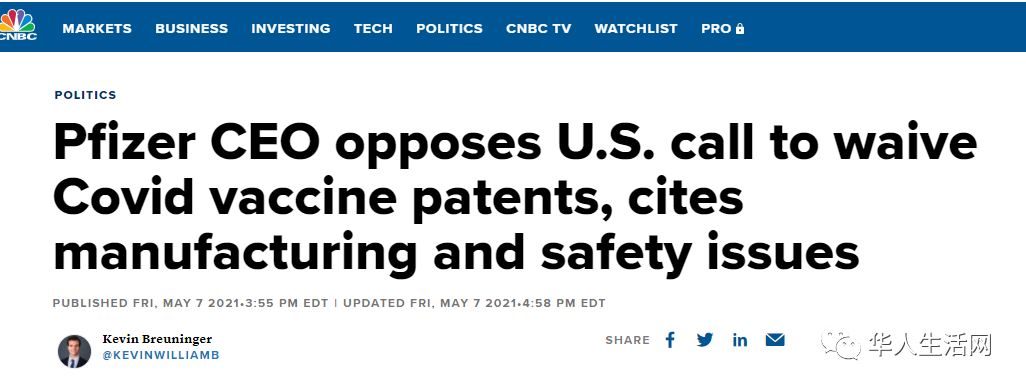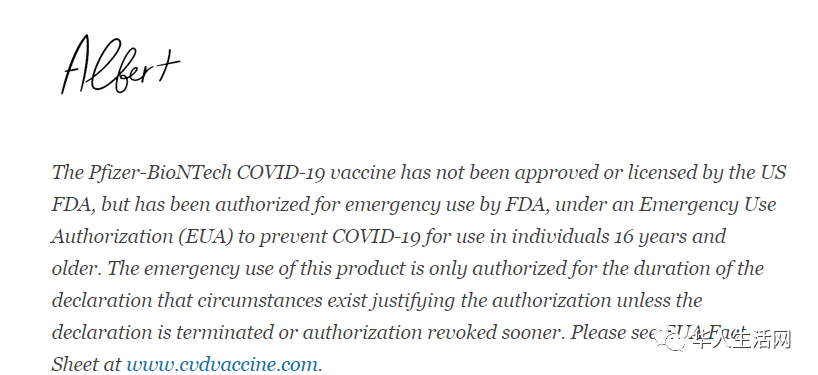最近美国政府疫苗专利权问题引起了大药厂的强烈震动,我们身在门外的人来看,这个问题就好像就是经济,政治各种力量的平衡,但事实呢?
在昨天网络上疯狂转载了一封辉瑞CEO给全体员工的信。

信的本质内容是探讨辉瑞的核心价值以及长期以来的努力,但是也让网友们看到了这家新冠疫苗厂在背后的一些故事。

亲爱的同事们:
最近,美国贸易代表宣布将讨论放弃一些COVID-19疫苗知识产权(IP)的选项,这给世界带来了一些困惑。辉瑞公司在确保公平和公正地分配我们的COVID-19疫苗方面做得够吗?拟议的豁免权是要带来解决方案还是制造更多问题?我今天写信给你,想讨论这些问题。
公平和公正的分配从第一天起就是我们的北极星。为了确保每个国家都能获得我们的COVID-19疫苗,必须满足两个条件:任何人都能负担得起的价格和为所有人可靠地制造足够的疫苗。
第一个条件在早期就已满足。早在2020年6月,我们决定通过分级定价提供我们的疫苗。
较富裕的国家将需要支付大约一顿外卖的费用,并向其公民免费提供疫苗。
中等收入国家以大约一半的价格提供剂量。
低收入国家则以成本价提供剂量。
许多最贫穷的社区将通过捐赠获得他们的剂量。
公平并不意味着我们给每个人都是一样的。公平意味着我们为那些需要更多的人提供更多。
满足第二个条件的挑战要大得多,但我们正在以惊人的速度实现这一目标。由于我们的科学家、工程师和技术工人的聪明才智和辛勤工作,以及辉瑞数十亿美元的投资,我们宣布,我们将在2021年向世界提供超过25亿剂的药物。事实上,我们的内部目标是30亿剂,所以我们对我们的承诺感到相当放心。今年实现30亿剂意味着,通过推断,2022年将达到40亿剂。这些剂量不是针对富人或穷人,不是针对北方或南方。这些是为所有人提供的剂量。我们已经与116个国家签订了供应协议,目前我们正在与更多的国家进行深入谈判,2021年的总剂量约为27亿剂。在敲定所有协议后,我们预计其中的40%,即超过10亿剂,将在2021年用于中低收入国家。
这显然提出了另一个问题。到今天为止,我们已经运送了大约4.5亿剂,余额对高收入国家更有利。AD
这是为什么呢?
当我们制定分级定价政策时,我们联系了所有国家,要求他们下订单,以便我们能够为他们分配剂量。
实际上,当时高收入国家马上同意,并保留了大部分的剂量。我个人那时开始关注这个问题,我通过信件、电话甚至短信联系了许多中/低收入国家的负责人,敦促他们保留剂量,因为供应有限。
然而,他们中的大多数人决定向其他疫苗制造商下订单,因为当时mRNA技术还没有经过测试,或者因为他们得到了本地生产的选择。有些人甚至没有批准我们的疫苗。
不幸的是,其他疫苗生产商由于不同的技术原因,无法履行其供应承诺。大多数最初没有选择我们的国家回来了,由于我们惊人的供应量增加,我们已经开始与他们签署供应协议。我们预计在2021年下半年,供应平衡将对他们有利,并且在2022年几乎有足够的供应给所有人。
上周,我有机会向美国贸易代表提供这些事实,并解释为什么建议放弃知识产权只会破坏这一进展。这使我想到了第二个问题。建议的豁免是要改善供应状况还是制造更多问题?我的答案是绝对的后者。
当我们创建我们的疫苗时,世界上任何地方都没有任何mRNA疫苗或药物的生产。我们不得不从头开始创建生产基础设施。凭借172年的优质制造传统,大量的资本部署,以及更重要的是,一支由高度熟练的科学家、工程师和制造工人组成的军队,我们在创纪录的时间内开发了世界上有史以来最高效的救命疫苗的制造机器。
目前,基础设施不是我们制造速度的瓶颈。限制因素是生产我们的疫苗所需的高度专业化原材料的稀缺。这280种不同的材料或部件是由19个不同国家的许多供应商生产的。他们中的许多人需要我们的大量支持(技术和资金)来提高他们的生产。现在,几乎每一克生产的原材料都被立即运入我们的生产设施,并立即可靠地转化为疫苗,立即运往世界各地(迄今有91个国家)。拟议的COVID-19疫苗豁免,有可能破坏原材料的流动。它将引发对我们所需的关键投入的争夺,以制造安全和有效的疫苗。在制造疫苗方面几乎没有经验的实体可能会追逐我们扩大生产规模所需的原材料,从而使所有人的安全和安保受到威胁。
我还想说最后一点。我担心放弃专利保护会使其他任何人不敢冒大风险。
在我们知道是否能成功开发出疫苗之前,我们就已经部署了20亿美元,因为我们明白这其中的风险。就在最近,我授权在COVID-19的研究和开发上再支出6亿美元,这将使我们在2021年的研发总支出超过100亿美元。AD
当然,最近的言论不会阻止我们继续投资于科学。但我不确定对于数以千计的小型生物技术创新者来说是否也是如此,他们完全依赖从投资者那里获得资金,而这些投资者投资的前提是其知识产权将得到保护。
结束大流行病和为世界接种疫苗是一项巨大的、但可以实现的事业。
我们仍然完全专注于尽快为世界各地的患者提供高质量、安全和有效的疫苗,并结束这一致命的大流行病。
再一次,我们不会让政治阻碍我们的工作,我们将继续做我们最擅长的事情--创造改变患者生活的突破。

这位CEO一看就是科学家出身,写东西非常有逻辑。

当然这也让我们看到了原来一开始疫苗订制上,有这么多故事,但是贫困的国家真没有钱买廉价疫苗吗?还是这些国家从一开始就没想真正对待疫情和自己的公民?
全美几万人去年夏天开始就做疫苗志愿者,而仅仅辉瑞一家家普通的药厂为了疫苗就投入了几十亿美元,到头来却要变成无偿捐献,不捐还要被骂自私自利,小编不知道这到底是不是算合理呢?也可能这种大爱我无法理解吧。
不知大家又是如何看待这个问题的。
Today I Sent This Letter To Have a Candid Conversation With Our Colleagues About the Drivers of COVID-19 Access and Availability
Chairman and Chief Executive Officer,Pfizer、
The recent announcement that the UnitedStates Trade Representative will discuss options to waive some COVID-19 vaccineintellectual property (IP) rights has created some confusion to the world. HasPfizer done enough to ensure fair and equitable distribution of our COVID-19vaccine? Is the proposed waiver going to bring solutions or create moreproblems? I am writing to you today to discuss these questions.
Fair and equitable distribution was our North Star from day one. In order to ensure that every country can have access to our COVID-19 vaccine two conditions had to be met: a price that anyone canafford and reliable manufacturing of enough vaccine for all.
The first condition was met in the early days. Back in June of 2020 we decided to offer our vaccine through tieredpricing. The wealthier nations would have to pay in the range of about the costof a takeaway meal and would offer it to their citizens for free. Themiddle-income countries were offered doses at roughly half that price and thelow-income countries were offered doses at cost. Many of the poorest communities will receive their doses through donation. Equity doesn’t mean we give everyone the same. Equity means we give more to those that need more.
Meeting the second condition was much more challenging but we are getting there with remarkable speed. Thanks to theingenuity and hard work of our scientists, engineers and skilled workers, and multibillion dollars of Pfizer investment, we announced that we will provide to the world more than 2.5 billion doses in 2021. In fact, our internal target is 3 billion doses, so we feel quite comfortable about our commitment. Achieving 3 billion doses this year means, by extrapolation, 4 billion doses in 2022. These doses are not for the rich or poor, not for the north or south. These are doses for ALL. We have concluded agreements to supply 116 countries and we are currently in advanced negotiations with many more for a total of approximately 2.7 billion doses in 2021. Upon finalization of all agreements, we expect that 40% of them, or more than 1 billion doses, will go to middle- and low-income countries in 2021.
This clearly poses another question. Until today, we have shipped approximately 450 million doses and the balance is more favorable to high income countries. Why is that? When we developed our tiered pricing policy, we reached out to all nations asking them to place orders so we could allocate doses for them. In reality, the high-income countries reservedmost of the doses. I became personally concerned with that and I reached out to many heads of middle/low-income countries by letter, phone and even text to urge them to reserve doses because the supply was limited. However, most of them decided to place orders with other vaccine makers either because mRNA technology was untested at that time or because they were offered local production options. Some didn’t even approve our vaccine. Unfortunately, other vaccine producers were not able to meet their supply commitments for varying technicalreasons. Most of the countries that did not choose us initially, came back and thanks to our phenomenal supply ramp up, we have started signing supply agreements with them. We expect the supply balance to weigh in their favor in the second half of 2021, and to have virtually enough supply for all in 2022.
Last week, I had the opportunity to provide these facts to the US Trade Representative and explain why the suggested waiver of IP rights could only derail this progress. Which brings me to the second question. Is the proposed waiver going to improve the supply situation or create more problems? And my answer is categorically the latter.
When we created our vaccine there was no manufacturing production of any mRNA vaccine or medicine anywhere in the world. We had to create manufacturing infrastructure from scratch. With 172 years of quality manufacturing tradition, substantial deployment of capital, and more importantly, an army of highly skilled scientists, engineers and manufacturingworkers, we developed in record time the most efficient manufacturing machine of a life-saving vaccine that the world has ever seen. Currently, infrastructure is not the bottleneck for us manufacturing faster. The restriction is the scarcity of highly specialized raw materials needed to produce our vaccine. These 280 different materials or components are producedby many suppliers in 19 different countries. Many of them needed our substantial support (technical and financial) to ramp up their production. Right now, virtually every single gram of raw material produced is shipped immediately into our manufacturing facilities and is converted immediately and reliably to vaccines that are shipped immediately around the world (91countries to date.) The proposed waiver for COVID-19 vaccines, threatens to disrupt the flow of raw materials. It will unleash a scramble for the critical inputs we require in order to make a safe and effective vaccine. Entities with little or no experience in manufacturing vaccines are likely to chase the very raw materials we require to scale our production, putting the safety and security of all at risk.
And I would like to make a final point. I worry that waiving of patent protection will disincentivize anyone else from taking a big risk. We deployed $2 billion before we knew whether we could successfully develop a vaccine because we understood what was at stake. Just recently, I authorized spending an additional $600 million on COVID-19 research and development that will bring our total spend for R&D in 2021 to more than $10 billion . The recent rhetoric will not discourage us from continuing investing in science. But I am not sure if the same is true for the thousands of small biotech innovators that are totally dependent on accessing capital from investors who invest only on the premise that their intellectual property will be protected.
Ending the pandemic and vaccinating the world is a massive, but achievable undertaking. We remain fully focused on getting high-quality, safe and effective vaccines to patients all over the world as quickly as possible and to putting an end to this deadly pandemic.
Once again, we will not let politics stand in our way and we will continue doing what we do best – creating breakthroughs that change patients’ lives.


来源网络





